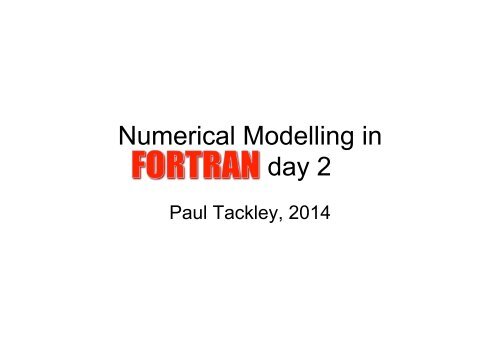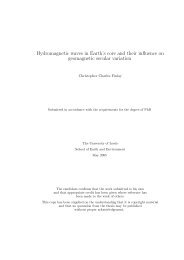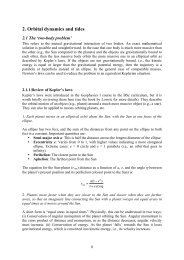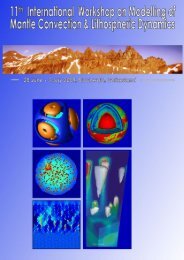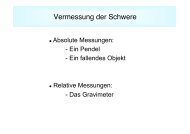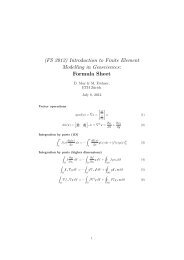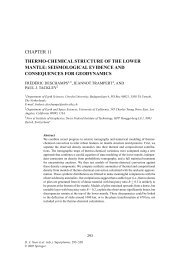Numerical Modelling in Fortran: day 2
Numerical Modelling in Fortran: day 2
Numerical Modelling in Fortran: day 2
You also want an ePaper? Increase the reach of your titles
YUMPU automatically turns print PDFs into web optimized ePapers that Google loves.
<strong>Numerical</strong> <strong>Modell<strong>in</strong>g</strong> <strong>in</strong><br />
<strong>Fortran</strong>: <strong>day</strong> 2<br />
Paul Tackley, 2014
Goals for to<strong>day</strong><br />
• Review ma<strong>in</strong> po<strong>in</strong>ts <strong>in</strong> onl<strong>in</strong>e materials you<br />
read for homework<br />
– http://www.cs.mtu.edu/%7eshene/COURSES/cs201/NOTES/<strong>in</strong>tro.html<br />
• More details about loops<br />
• F<strong>in</strong>ite difference approximation<br />
• Introduce and practice<br />
– subrout<strong>in</strong>es & functions<br />
– arrays
Miscellaneous th<strong>in</strong>gs<br />
• Cont<strong>in</strong>u<strong>in</strong>g l<strong>in</strong>es:<br />
– f95 use ‘&’ at the end of the l<strong>in</strong>e<br />
– f77: put any character <strong>in</strong> column 6 on next l<strong>in</strong>e<br />
• Formats of constants:<br />
– Use ‘.’ to dist<strong>in</strong>guish real from <strong>in</strong>teger (avoid 2/3=0 !)<br />
– 1.234x10 -13 is written as 1.234e-13<br />
• logical variables have 2 values: .true. or .false.<br />
• Variable nam<strong>in</strong>g rules:<br />
– start with letter<br />
– mix numbers, letters and _<br />
– no spaces
Character/str<strong>in</strong>g def<strong>in</strong>itions<br />
• character :: a<br />
(s<strong>in</strong>gle character)<br />
• character(len=10) :: a (str<strong>in</strong>g of length 10)<br />
• character :: a*10, b*5<br />
• character*15:: a,b<br />
(fortran77 style)<br />
• character(len=*) :: Name=‘Paul’<br />
– automatic length, otherwise str<strong>in</strong>gs will be<br />
truncated or padded with spaces to fit declared<br />
length
Initialis<strong>in</strong>g variables<br />
• Always <strong>in</strong>itialise variables! (don’t<br />
assume they will automatically be set to<br />
0, for example)<br />
• Either<br />
– when def<strong>in</strong>ed, e.g., real:: a=5.<br />
– <strong>in</strong> the program, e.g., a=5.0<br />
– read from keyboard or file
Arithmetic operators<br />
• e.g., what does a+b*c**3 mean<br />
– ((a+b)*c)**3 a+(b*c)**3 etc.<br />
– No! correct is: a+(b*(c**3))<br />
– priority is **, (* or /) then (+ or -)<br />
• Also LOGICAL operators, <strong>in</strong> this priority:<br />
– .not., .and., .or., (.eqv. or .neqv.)<br />
• Be careful mix<strong>in</strong>g variable types (e.g.<br />
<strong>in</strong>teger & real) <strong>in</strong> the same expression!
Some <strong>in</strong>tr<strong>in</strong>sic mathematical<br />
functions<br />
• abs (absolute value, real or <strong>in</strong>teger)<br />
• sqrt (square root)<br />
• s<strong>in</strong>, cos, tan, as<strong>in</strong>, acos, atan, atan2:<br />
assume angles are <strong>in</strong> radians<br />
• exp and log : log is natural log, use log10<br />
for base 10.<br />
• also cosh, s<strong>in</strong>h, tanh<br />
• for full list see a manual
Some conversion functions<br />
• Int(a): round to smaller # (4.7->4; -4.6->-4)<br />
• N<strong>in</strong>t(a): nearest <strong>in</strong>teger (4.7->5; -4.6->-5)<br />
• Floor(a): (4.7->4; -4.6->-5)<br />
• Ceil<strong>in</strong>g(a): (4.7->5; -4.6->-4)<br />
• Float(i): <strong>in</strong>teger -> real<br />
• Real(c): real part of complex<br />
• mod(a,b) is rema<strong>in</strong>der of x-<strong>in</strong>t(x/y)*y<br />
• max(a,b,c,….), m<strong>in</strong>(a,b,c,…)
ead(*,*) and write(*,*)<br />
• read(*,*) and write(*,*) do the same th<strong>in</strong>g as<br />
read* and pr<strong>in</strong>t* but are more flexible:<br />
– The 1st * can be changed to a file number, to<br />
read or write from a file<br />
– The 2nd * can be used to specify the format<br />
(e.g., number of decimal places)<br />
• More about this later <strong>in</strong> the course!
do<br />
loops:<br />
more<br />
types
functions and subrout<strong>in</strong>es<br />
• Useful for perform<strong>in</strong>g tasks that are<br />
performed more than once <strong>in</strong> a program<br />
and/or<br />
• Modularis<strong>in</strong>g (splitt<strong>in</strong>g up <strong>in</strong>to logical<br />
chunks) the code to make it more<br />
understandable<br />
• A function returns a value, a subrout<strong>in</strong>e<br />
doesn’t (except through chang<strong>in</strong>g its<br />
arguments)
example functions
same th<strong>in</strong>g as subrout<strong>in</strong>es (less elegant)
Internal vs. external functions<br />
• Internal functions (f90-) are conta<strong>in</strong>ed<br />
with<strong>in</strong> the program, and therefore the<br />
compiler can l<strong>in</strong>k them easily<br />
• External functions are def<strong>in</strong>ed outside the<br />
ma<strong>in</strong> program, so the call<strong>in</strong>g rout<strong>in</strong>e must<br />
declare their type (e.g., <strong>in</strong>teger, real).<br />
– In f90 it is also possible to specify the type of<br />
all the arguments, us<strong>in</strong>g an explicit <strong>in</strong>terface<br />
block, which has various advantages.
Example <strong>in</strong>ternal function
…and as an external function
A<br />
r<br />
r<br />
a<br />
y<br />
s
Notes<br />
• Indices start at 1 and go up to the declared<br />
value, e.g., if declare a(5) then it has<br />
components a(1),a(2)…a(5)<br />
• To get a different lower <strong>in</strong>dex, e.g., a(-5:5)<br />
• In subrout<strong>in</strong>es&functions an argument can<br />
be used to dimension arrays<br />
• In allocate statements other variables can be<br />
used<br />
• Use of the (a,$) format <strong>in</strong> write avoids<br />
carriage return at the end<br />
• Note implicit do loop n(j),j=1,3
Homework<br />
• At the ‘<strong>Fortran</strong> 90 Tutorial’ at<br />
http://www.cs.mtu.edu/%7eshene/<br />
COURSES/cs201/NOTES/fortran.html<br />
• Read through the sections<br />
– Selective Execution<br />
– Repetitive Execution<br />
– Functions (not modules - yet)<br />
• Do the exercises on the next slides and<br />
hand <strong>in</strong> by email (.f90 files)
Exercise 1: statements & loops<br />
• Write statements to<br />
– Declare a str<strong>in</strong>g of length 15 characters<br />
– Declare an <strong>in</strong>teger parameter = 5<br />
– Declare a 1-dimensional array with <strong>in</strong>dices runn<strong>in</strong>g from<br />
-1 to +10<br />
– Declare a 4-dimensional allocatable array<br />
– Convert a real number to the nearest <strong>in</strong>teger<br />
– Calculate the rema<strong>in</strong>der after a is divided by b<br />
• Write loops to<br />
– Add up all even numbers between 12 and 124<br />
– Test each element of array a(1:100) start<strong>in</strong>g from 1; if the<br />
element is positive pr<strong>in</strong>t a message to the screen and<br />
leave the loop
Exercise 2: Mean and standard deviation<br />
• Convert your mean & stddev program from<br />
last week <strong>in</strong>to a function or subrout<strong>in</strong>e<br />
that operates on a 1-D array passed <strong>in</strong> as<br />
an argument.<br />
• Write a ma<strong>in</strong> program that<br />
– asks for the number of values,<br />
– allocates the array,<br />
– reads the values <strong>in</strong>to the array,<br />
– calls the function you wrote and<br />
– pr<strong>in</strong>ts the result<br />
• A function can’t return both mean & stddev,<br />
so one of them will have to be an argument
Derivatives us<strong>in</strong>g f<strong>in</strong>ite-differences<br />
• Graphical <strong>in</strong>terpretation: df/dx(x) is<br />
slope of (tangent to) graph of f(x) vs. x<br />
• Calculus def<strong>in</strong>ition:<br />
df<br />
dx ≡ f ′ (x) ≡ lim<br />
dx→ 0<br />
f (x + dx) − f (x)<br />
dx<br />
• Computer version (f<strong>in</strong>ite differences):<br />
f ′(x) = f (x 2 ) − f (x 1 )<br />
x − x 2 1
F<strong>in</strong>ite Difference grid <strong>in</strong> 1-D<br />
• Grid po<strong>in</strong>ts x 0 , x 1 , x 2 …x N<br />
• Here xi=x 0 +i*h<br />
• Function values y 0 , y 1 , y 2 …y N<br />
• Stored <strong>in</strong> array y(i)<br />
• (<strong>Fortran</strong>, by default, starts<br />
arrays at i=1, but you can<br />
change this to i=0)<br />
⎛<br />
⎝<br />
⎜<br />
dy<br />
dx<br />
⎞<br />
⎠<br />
⎟<br />
i<br />
≈ Δy<br />
Δx<br />
=<br />
y(i +1) − y(i)<br />
h
Concept of Discretization<br />
• True solution to equations is cont<strong>in</strong>uous <strong>in</strong><br />
space and time<br />
• In computer, space and time must be<br />
discretized <strong>in</strong>to dist<strong>in</strong>ct units/steps/po<strong>in</strong>ts<br />
• Equations are satisfied for each unit/step/<br />
po<strong>in</strong>t but not necessarily <strong>in</strong>between<br />
• <strong>Numerical</strong> solution approaches true solution<br />
as number of grid or time po<strong>in</strong>ts becomes<br />
larger
Analysis<br />
• Subrout<strong>in</strong>e arguments can have<br />
different names from those <strong>in</strong> call<strong>in</strong>g<br />
rout<strong>in</strong>e: what matters is order<br />
• FD approximation becomes more<br />
accurate as grid spac<strong>in</strong>g dx decreases<br />
• Allocate argument arrays <strong>in</strong> the call<strong>in</strong>g<br />
rout<strong>in</strong>e, not <strong>in</strong> the subrout<strong>in</strong>e/function
Summary: first derivative<br />
dy<br />
dx ≈ Δy<br />
Δx =<br />
y i − y i−1<br />
x i<br />
− x i−1<br />
=<br />
y i − y i−1<br />
h<br />
• Second derivative<br />
⎛<br />
⎜<br />
⎝<br />
∂ 2 y ⎞<br />
∂x 2 ⎟<br />
⎠<br />
i<br />
= y i+1 − 2y i + y i−1<br />
h 2
Exercise 3: Second derivative<br />
• Write a subrout<strong>in</strong>e that calculates the second<br />
derivative of an <strong>in</strong>put 1D array, us<strong>in</strong>g the f<strong>in</strong>ite<br />
difference approximation<br />
• The <strong>in</strong>puts will be the array, number of po<strong>in</strong>ts and grid<br />
spac<strong>in</strong>g.<br />
• The result<strong>in</strong>g 1-D array can be an <strong>in</strong>tent(out) argument.<br />
• Assume the derivative at the end po<strong>in</strong>ts is 0.<br />
• Test this rout<strong>in</strong>e by writ<strong>in</strong>g a ma<strong>in</strong> program that<br />
calls the subrout<strong>in</strong>e with two idealized functions for<br />
which you know the correct answer, e.g., s<strong>in</strong>(x),<br />
x**2.<br />
• Hand <strong>in</strong> your .f90 code and the results of your two<br />
tests


